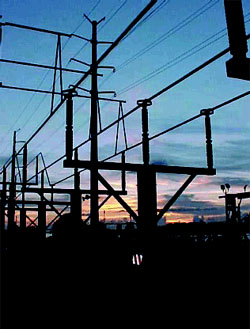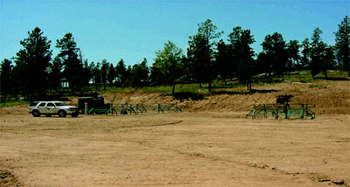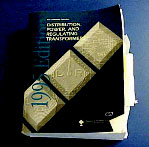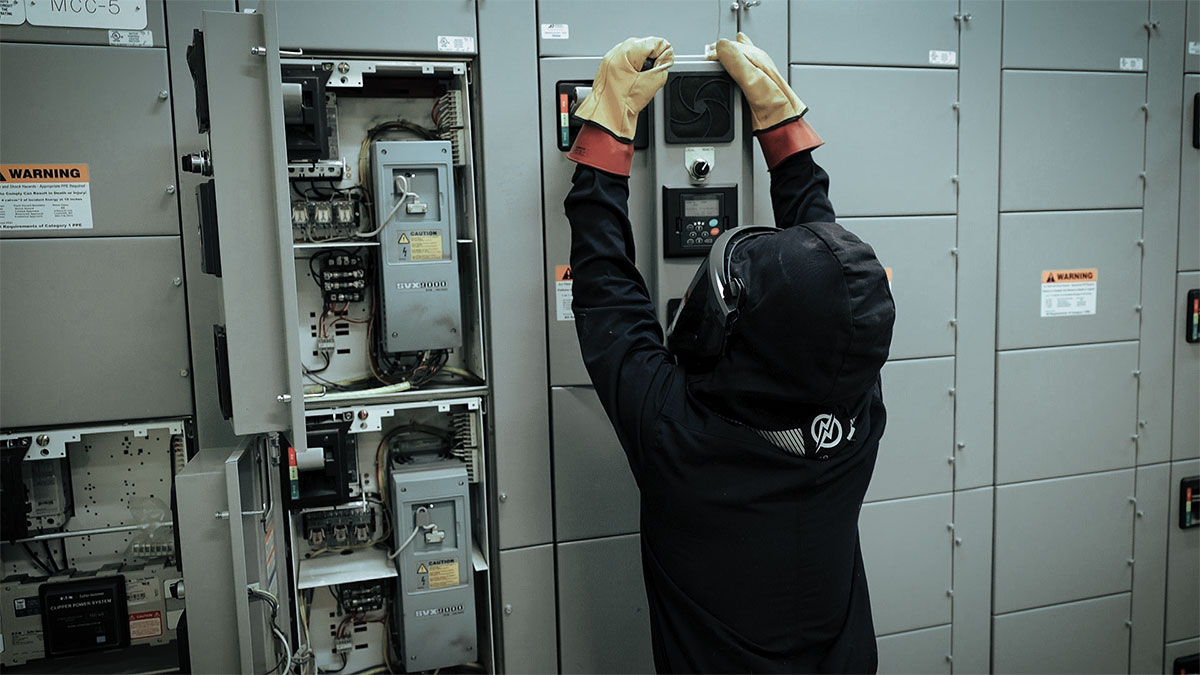Most people in the non-utility side of the electrical industry are very familiar with the design, installation and inspection of electrical systems rated 600 volts or less; primarily because these systems are numerous, and these people work with them daily. The one exception is the sign industry where higher voltages are used primarily for neon signs. As the use of power has evolved, industry personnel now need to learn about power systems that operate over 600 volts as they are becoming more common in many types of occupancies. This article will discuss where some of these high voltage systems are being installed, what other codes beyond the National Electrical Code and standards now have to be considered, and some of the safety aspects of working on or around these systems when energized.

Photo 1. Privately owned combination cycle generation facility
Where these systems are being installed
The National Electrical Code references three basic classes of electrical systems. Low voltage systems such as those found under Articles 411, 725, 760 and chapter 8. The other two classes are systems under 600 volts and systems over 600 volts. From the NEC perspective, systems over 600 volts are commonly referred to as “high voltage systems.”

Photo 2. Substation bus and take off structure
Electrical engineers, installers, inspectors and maintenance personnel are most familiar with the Code requirements, equipment and products used for installations under 600 volts. It should be noted that the NEC is not entirely consistent with the dividing line at 600 volts. The wire and cable ampacity tables are identified for 0 to 2000 volts and in Article 250, there is a part that is for grounding of systems over 1000 volts, for example. While this article will generally follow the Code convention of calling over 600 volt systems “high voltage,” it should be noted that according to the definitions established by the Institute of Electrical and Electronic Engineers (IEEE) and used internationally, what the Code refers to as “high voltage” is actually “medium voltage.” This difference in terms causes confusion at times when engineers and manufacturers will be discussing medium voltage equipment and the electrician and inspector are unsure of what is being talked about. Table 1 is provided for information on the IEEE voltage class definitions.
This difference in voltage definitions has generally not caused problems since nothing operated between 600 and 1000 volts. One case where it has become an issue is with 750 volts DC systems installed for light rail transit systems. Does one treat this as a low voltage system or a high voltage system?

Photo 3. Privately owned 4.16 kV compact unit substation serving a well on a large ranch
Historically, over 600 volt systems were primarily under the control of the utility with the main exception being certain heavy industries such as steel mills, pulp and paper, and chemical plants. Due to the very large loads these types of facilities utilized, medium voltage systems were required. In the last 30 years three factors have influenced the change so more of the electrical industry now has to deal with over 600 volt systems. One of these factors was larger blocks of power required in other than the traditional heavy industries and the economic rate benefits of receiving service at medium voltage. It is not uncommon today to see over 600 volt systems installed in schools (university campuses, community colleges, high schools and even elementary schools), commercial office buildings, shopping centers and malls, hospitals, light industrial facilities, care centers for the elderly, and even in some one and two family dwellings. One example of this last case is a single-family home in the Northwest that takes service from the utility at 21 kV. The service equipment is a single 25 kV class outdoor metal enclosed fused switch with primary metering. The 21 kV feeder is installed underground for approximately 1 mile to a 21 kV to 208/120 volt pad mounted transformer near the home. A 208/120 volt feeder is installed into the dwelling from the transformer. Examples of some of these installations are shown in photos 1, 2, and 3.

Photo 4. Examples of standards collections published by IEEE
The second factor is an increasing voltage for services and feeders used by large heavy industries to meet increased power demands of the modern process plant. Initially, typical industrial systems were in the 5 or 15 kV class. Actual system voltages included 2.3 kV, 4.16 kV, 12.47 kV, 13.2 kV or 13.8 kV. In some industries, such as pulp and paper, several large motors were operated at 2300 or 7200 volts served from medium voltage motor control centers. Today, with long term rate and installed cost savings for the use of higher voltages, some plants have supply systems at 21 kV, 34.5 kV, 69 kV, 115 kV, 138 kV and even 230 kV. There is one recycling continuous cast steel mill with the main arc furnace substation supplied directly from the grid operating at 230 kV. The supply to the 75 MVA arc furnace transformer is at 34.5 kV. This supply disconnect is indoors using a large open air breaker, and the room serves as the enclosure. Interlocks on all access doors are provided to positively trip this air breaker if a door is opened while the system is energized. In addition, this facility has three additional 12.47 kV services from the local municipal utility substation to operate the rest of the mill.
The third factor happening more recently is utility de-regulation. One aspect of de-regulation is that utilities are selling substations to private facilities when that substation had been dedicated to the one plant. These substations were designed, constructed, operated and maintained exclusively by the utility and therefore were exempt by Section 90-2 of the Code. With the sale, the substation now belongs to private industry, which falls under the Code. The equipment was designed to the utility specifications and rarely has any third party listing, labeling or certification. Additionally, the installation was done according to the utility’s practices and the NEC was typically not used as a basis for the design or installation. This does not mean these installations are unsafe, the equipment unacceptable, or the design faulty. When serviced by trained and qualified personnel, as is the case with utilities, these substations have a long proven track record for reliability and safety. It means that the NEC has to address the substation differently, because there is no assurance that there will be well trained and qualified persons always working in the substation after the private owner takes over. This situation brings up one general problem that exits all over in the electrical industry today, not having an adequate number of qualified personnel to design, install, operate or maintain these systems. Many times the maintenance man, janitor, or a local electrical contactor is employed who has not been trained nor has the experience to deal with this equipment. Another problem that comes from the second factor is that in more and more cases the system voltage is now exceeding the upper limits dealt with in the NEC.
Codes that apply

Photo 5. Examples of standards collections published by IEEE
Two primary codes apply to these systems. As previously discussed, the National Electrical Code has many sections and all of Article 490 that deal with over 600 volt systems. The other code, which is now being featured regularly in IAEI News, is the National Electrical Safety Code (NESC). Typically, most utilities use the NESC, in part or in total, as the basis for their design, installation and operating practices. Some aspects of over 600 volt installations are not yet addressed in the NEC. One example is outdoor overhead uninsulated feeders such as one commonly sees along the street for the utility distribution system. Intuitively, it seems safe because of the history from the utility industry, but what does an electrical inspector use to determine if it is installed correctly when it does not belong to a utility? To address this question and other like areas, many jurisdictions are adopting the NESC along with the NEC to form the basis for their electrical safety law. To prevent conflicts, the enabling regulations will indicate that where both the NEC and the NESC cover a situation, the NEC shall take precedence.
In addition to these two codes, there are hundreds of standards for all the products, components, equipment, insulation, etc. American Society for Testing of Materials (ASTM) standards typically are referenced for insulation formulation and test qualifications. These standards cover such things as mineral oil used in transformers and switches, rubber materials, ceramics, and glass polyester insulating materials. The IEEE has three specialty societies that address the majority of the standards in this area. These societies are the Power Engineering Society, Electrical Insulation Society and the Industry Applications Society. Photos 4 and 5 are examples of standards collections published by IEEE and Table 2 identifies some of the equipment these standards collections cover. In addition, there are some UL standards for high voltage equipment with some examples shown in Table 2.
Safety aspects of working on these systems

Photo 6. Shows an indoor line of 15 kV class distribution equipment
What all this means is that to design, install or inspect these type systems, the individuals involved must be aware of and learn about a lot more information. Even though there is so much more, most of it has the same basic principles that are applied to under 600 volt systems. These include:
- Protection of conductors from physical damage and damage from electrical faults and overloads
- Protection of equipment from physical and electrical damage
- Protection of people by limiting access, providing adequate working clearances, providing training to qualify personnel for the task they are assigned and proper procedures, including personal protective equipment, for working on or around energized equipment.
The main thing to understand is that medium and high voltage equipment is physically larger, has much greater available energy levels, and requires greater clearances and space to be provided as the voltage increases. Photo 6 shows an indoor line of 15 kV class distribution equipment. This line has one main and eight feeder breakers and, as can be seen, fills this room.
If one has to work around or inspect equipment rated more than 600 volts, several basic safety principles need to be followed. Before one approaches this equipment, he or she must be sure that he or she has a good understanding of what the equipment is and how it operates. If the equipment is or has been energized and is not proven to be de-energized, one must be trained in all the safety aspects of completing the task per OSHA regulations. One needs to always wear appropriate personal protective equipment and should never touch the internal parts of energized electrical equipment until it is proven to be de-energized and grounded or unless one is trained to work hot with appropriate insulated tools. Personal protective equipment, under the OSHA regulations, include a minimum of:
- Head protection, such as a properly rated hard hat
- Eye protection with properly rate safety glasses, a full face shield or a full hood
- Hand protection with properly rated and tested insulating gloves with protectors
- Where blast hazards exist, a full blast suit rated for the expected energy from an arc blast needs to be worn.
With regard to conductors, some are shielded and some are not. In either case, there can be dangerous potentials on the outer jacket. One should never touch an energized cable operating over 600 volts. It should be noted that the black housing on load break elbows is many times made of a semiconductive material and is not a full insulator. After a cable is de-energized, the main conductor can maintain a charge for a long time. Before touching it with bare hands or otherwise contacting the conductor, one should make certain that it is grounded to ensure that charge is bled off. If testing of cables or equipment is underway, use extreme caution as test voltages can be up to 5 or more times higher than the operating voltage.
When approaching enclosures of energized equipment, one should not open doors or remove covers while energized unless one is specifically trained and qualified. The clearance behind those covers can be close and one may not know of the bad hinge, loose hardware or ionized gas that may just be waiting for someone to trigger a fault. All enclosures that have over 600 volt equipment need to have proper warning signs. The sign needs to identify the level of hazard, usually “Danger”; what the hazard is, “High Voltage” and a command such as, “Keep Out.”
In summary, keep in mind these points:
- Understand the equipment you are working on.
- Give yourself clearance to work safely.
- Understand the ratings of the equipment.
- Be aware of the other standards that apply to this class of equipment.
- Work safely.














Find Us on Socials